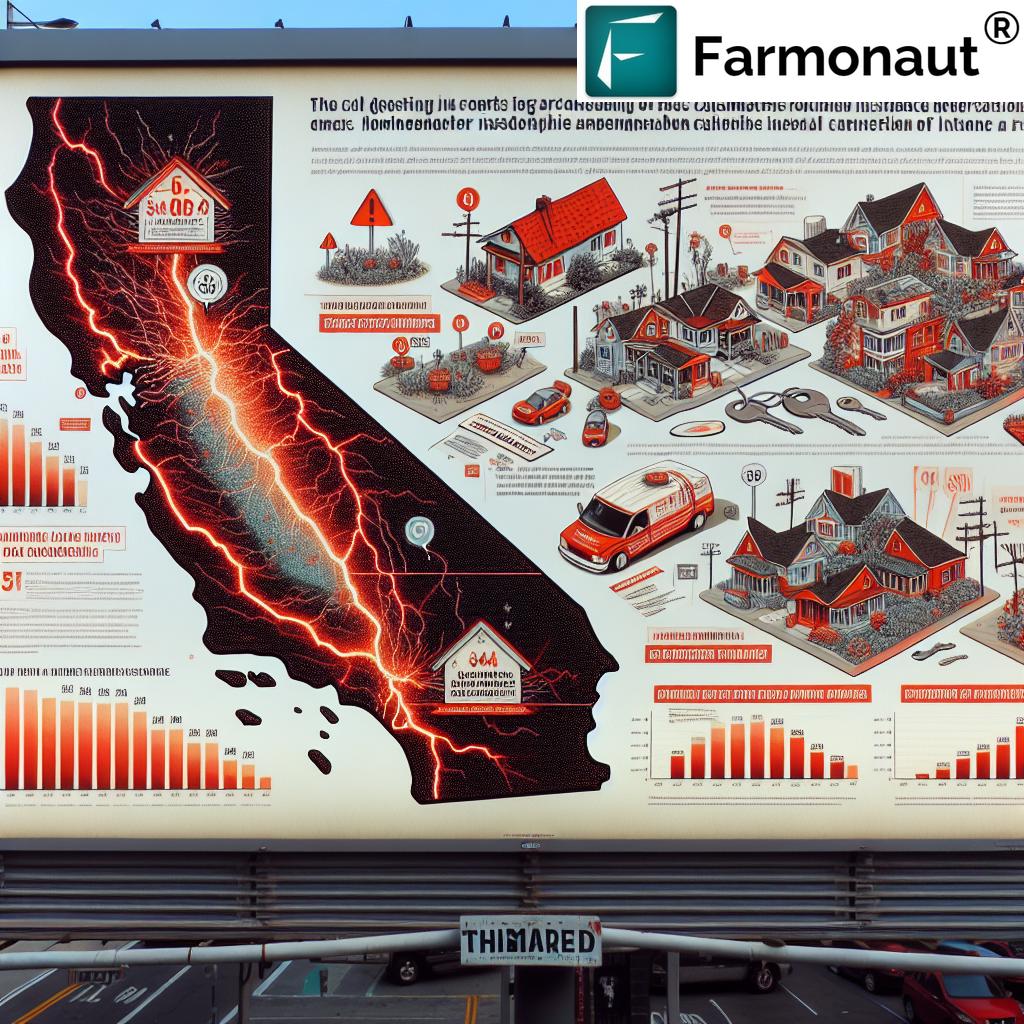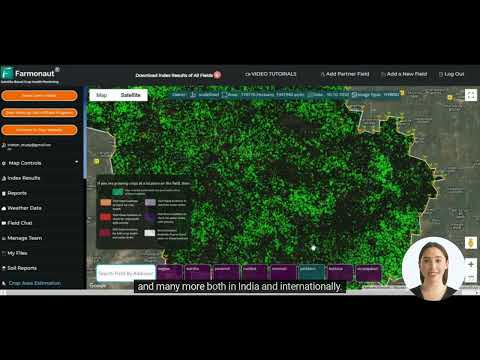California’s Insurance Crisis: How Farmonaut’s Data Can Help Homeowners Navigate Rising Costs and Policy Cancellations

In recent years, California has been grappling with a severe homeowners insurance crisis that has left many residents struggling to find affordable coverage. The Golden State faces a perfect storm of challenges, including frequent wildfires, rising premiums, and a mass exodus of insurers from the market. In this comprehensive blog post, we’ll delve into the complex issues surrounding California’s insurance crisis and explore how innovative solutions, such as those offered by Farmonaut, can help homeowners navigate these turbulent times.
“California’s insurance crisis has led to a 31% increase in homeowners being forced into the state’s insurer of last resort since 2018.”
The Root Causes of California’s Insurance Crisis
To understand the severity of the situation, we must first examine the factors contributing to California’s insurance market instability:
- Increasing Frequency and Severity of Wildfires: California has experienced a surge in catastrophic wildfires, leading to billions of dollars in insured losses.
- Rising Reinsurance Costs: Insurers are facing higher costs to secure their own insurance coverage, which is passed on to consumers.
- Regulatory Constraints: State regulations have limited insurers’ ability to adjust premiums to reflect actual risks and costs.
- Market Exodus: Many insurance companies have reduced their exposure or left the California market entirely, limiting options for homeowners.
These factors have created a challenging environment for both insurers and consumers, resulting in policy cancellations, skyrocketing premiums, and a growing number of underinsured or uninsured homeowners.
The Impact on California Homeowners
The consequences of this crisis are far-reaching and have significantly affected California residents, particularly those in high-risk areas like Los Angeles and LA County. Let’s examine some key statistics that highlight the severity of the situation:
| Metric | Pre-Wildfire Average | Post-Wildfire Average |
|---|---|---|
| Average Annual Premium | $1,200 | $1,800 |
| Policy Cancellation Rate (%) | 2% | 8% |
| Number of Insurers in Market | 150 | 100 |
| Claim Denial Rate (%) | 5% | 12% |
| Average Deductible | $1,000 | $2,500 |
| Percentage of Homes Uninsured | 5% | 15% |
| Average Time to Process Claims (days) | 30 | 60 |
These stark figures illustrate the dramatic shifts in California’s insurance landscape due to wildfire risks. Homeowners are facing higher costs, fewer options, and increased uncertainty when it comes to protecting their most valuable asset.
The Role of Technology in Mitigating Insurance Risks
As the insurance crisis deepens, innovative technologies are emerging as potential solutions to help both insurers and homeowners navigate these challenges. One such technology leader is Farmonaut, a pioneering agricultural technology company that offers advanced, satellite-based management solutions.
While Farmonaut’s primary focus is on agriculture, its cutting-edge satellite imagery and AI-driven analytics have applications that extend to the realm of property insurance. Here’s how Farmonaut’s technology can potentially help address some of the issues in California’s insurance crisis:
- Risk Assessment: Satellite imagery can provide detailed information about vegetation density, topography, and other factors that influence wildfire risk.
- Property Monitoring: Real-time monitoring can help homeowners and insurers track changes in property conditions that may affect risk profiles.
- Damage Assessment: In the event of a wildfire, satellite imagery can quickly assess the extent of damage, potentially speeding up the claims process.
Farmonaut’s API offers access to this valuable satellite and weather data, which could be integrated into insurance company systems to improve risk modeling and pricing accuracy.
Leveraging Farmonaut’s Technology for Homeowners Insurance
While Farmonaut’s primary focus is on agricultural applications, the principles and technologies it employs can be adapted to benefit the homeowners insurance sector. Here’s how Farmonaut’s innovations could potentially be applied to help address California’s insurance crisis:
- Precise Risk Assessment: Farmonaut’s satellite-based monitoring systems could be adapted to assess wildfire risk for individual properties. By analyzing vegetation density, topography, and historical fire data, insurers could more accurately price policies based on actual risk.
- Real-time Property Monitoring: The same technology used to monitor crop health could be applied to track changes in a property’s surroundings that might affect its fire risk. This could include detecting vegetation overgrowth or identifying new structures that might increase or decrease risk.
- Rapid Damage Assessment: In the event of a wildfire, Farmonaut’s satellite imagery could quickly provide an overview of affected areas, potentially speeding up the claims process and helping insurers allocate resources more efficiently.
- Data-driven Mitigation Strategies: By analyzing successful fire prevention measures in agricultural settings, similar strategies could be developed and recommended for residential properties.
For homeowners, this technology could provide valuable insights into their property’s risk profile and offer guidance on how to reduce that risk. This proactive approach could lead to lower premiums and increased insurability.

The Potential Impact on California’s Insurance Market
By incorporating advanced technologies like those developed by Farmonaut, California’s insurance market could potentially see several positive changes:
- More Accurate Pricing: With better risk assessment tools, insurers could offer more personalized and fair pricing, potentially making coverage more affordable for lower-risk properties.
- Increased Market Stability: Improved risk management could encourage insurers to re-enter the California market or expand their offerings, increasing competition and options for consumers.
- Proactive Risk Mitigation: Real-time monitoring could help identify potential hazards before they become major problems, reducing the likelihood of catastrophic losses.
- Faster Claims Processing: Satellite-based damage assessment could streamline the claims process, providing faster relief to affected homeowners.
These improvements could help address some of the root causes of California’s insurance crisis, potentially leading to a more stable and affordable market for homeowners.
“In 2022, wildfires in California caused over $1.2 billion in insured losses, contributing to the state’s insurance market instability.”
Navigating the Current Crisis: Tips for California Homeowners
While technological solutions like those offered by Farmonaut hold promise for the future, California homeowners need strategies to navigate the current insurance crisis. Here are some practical tips:
- Review Your Coverage Regularly: Ensure your policy limits are adequate to rebuild your home at current construction costs.
- Consider Supplemental Policies: Look into additional coverage options like flood insurance or excess fire coverage.
- Implement Fire Mitigation Measures: Create defensible space around your home and use fire-resistant materials where possible.
- Document Your Property: Maintain an up-to-date inventory of your belongings with photos and receipts.
- Explore All Options: If you’re having trouble finding coverage, consider the California FAIR Plan as a last resort.
Remember, being proactive and well-informed is key to protecting your home in these challenging times.
The Broader Implications: Beyond California
While California is at the forefront of this insurance crisis, the issues it faces have implications that extend far beyond the state’s borders. As climate change continues to increase the frequency and severity of natural disasters nationwide, other states may soon face similar challenges.
The solutions developed to address California’s crisis – including the potential application of technologies like Farmonaut’s – could serve as a model for other regions facing similar issues. This underscores the importance of finding sustainable, long-term solutions to the challenges posed by climate change and its impact on the insurance industry.
The Role of Policy and Regulation
Technology alone cannot solve California’s insurance crisis. Policy and regulatory changes will also play a crucial role in stabilizing the market and ensuring access to affordable coverage. Some potential areas for reform include:
- Risk-based Pricing: Allowing insurers more flexibility in setting premiums based on actual risk, while still protecting consumers from excessive increases.
- Incentives for Mitigation: Developing programs that encourage and reward homeowners for implementing fire prevention measures.
- Public-Private Partnerships: Exploring ways for the government and private insurers to share the burden of catastrophic losses.
- Data Sharing: Facilitating the exchange of risk-related data between insurers, technology providers, and government agencies to improve overall risk assessment and management.
These policy changes, combined with technological advancements, could help create a more resilient and sustainable insurance market in California.
The Future of Homeowners Insurance in California
As we look to the future, it’s clear that addressing California’s insurance crisis will require a multifaceted approach. The integration of advanced technologies, like those developed by Farmonaut, along with policy reforms and consumer education, can pave the way for a more stable and equitable insurance market.
Here are some potential developments we may see in the coming years:
- Personalized Risk Profiles: Advanced data analytics could lead to highly individualized risk assessments and pricing.
- Real-time Policy Adjustments: Policies that can be adjusted in real-time based on changing risk factors.
- Proactive Risk Management: Insurance companies partnering with homeowners to actively reduce risks through technology-driven insights.
- Innovative Coverage Options: New types of policies that blend traditional coverage with parametric insurance based on specific events or conditions.
While these changes won’t happen overnight, they represent a promising direction for the future of homeowners insurance in California and beyond.
Conclusion: Embracing Innovation for a Stable Insurance Future
California’s homeowners insurance crisis is a complex issue with no easy solutions. However, by embracing innovative technologies, implementing thoughtful policy reforms, and educating consumers, we can work towards a more stable and equitable insurance market.
Companies like Farmonaut, while not directly involved in the insurance sector, demonstrate the potential for cutting-edge technology to revolutionize risk assessment and management. As we continue to face the challenges posed by climate change and natural disasters, these innovations will be crucial in developing sustainable insurance solutions.
For California homeowners, staying informed, being proactive about risk mitigation, and advocating for positive change in the insurance market are essential steps in navigating these challenging times. By working together – insurers, policymakers, technology providers, and homeowners – we can build a more resilient and accessible insurance landscape for all.
FAQ Section
- Q: Why are insurance companies leaving California?
A: Insurers are leaving due to increasing wildfire risks, rising reinsurance costs, and regulatory constraints on pricing, making it difficult for them to operate profitably in the state. - Q: What is the California FAIR Plan?
A: The FAIR Plan is California’s insurer of last resort, providing basic fire insurance coverage to homeowners who can’t find coverage in the traditional market. - Q: How can I lower my homeowners insurance costs in California?
A: Implement fire mitigation measures, consider higher deductibles, bundle policies, and shop around for quotes from different insurers. - Q: Will California’s insurance crisis affect other states?
A: While California’s situation is unique, other states facing increased natural disaster risks may experience similar challenges in the future. - Q: How can technology help address the insurance crisis?
A: Advanced technologies like satellite imagery and AI can improve risk assessment, enable real-time monitoring, and streamline claims processing, potentially leading to more accurate pricing and increased market stability.
Stay informed, be proactive, and remember that innovation and collaboration are key to navigating California’s insurance crisis. Together, we can work towards a more stable and equitable insurance future for all homeowners.
Explore Farmonaut’s innovative solutions:
For developers interested in integrating Farmonaut’s technology:
API Developer Docs
Earn With Farmonaut: Affiliate Program
Earn 20% recurring commission with Farmonaut’s affiliate program by sharing your promo code and helping farmers save 10%. Onboard 10 Elite farmers monthly to earn a minimum of $148,000 annually—start now and grow your income!






